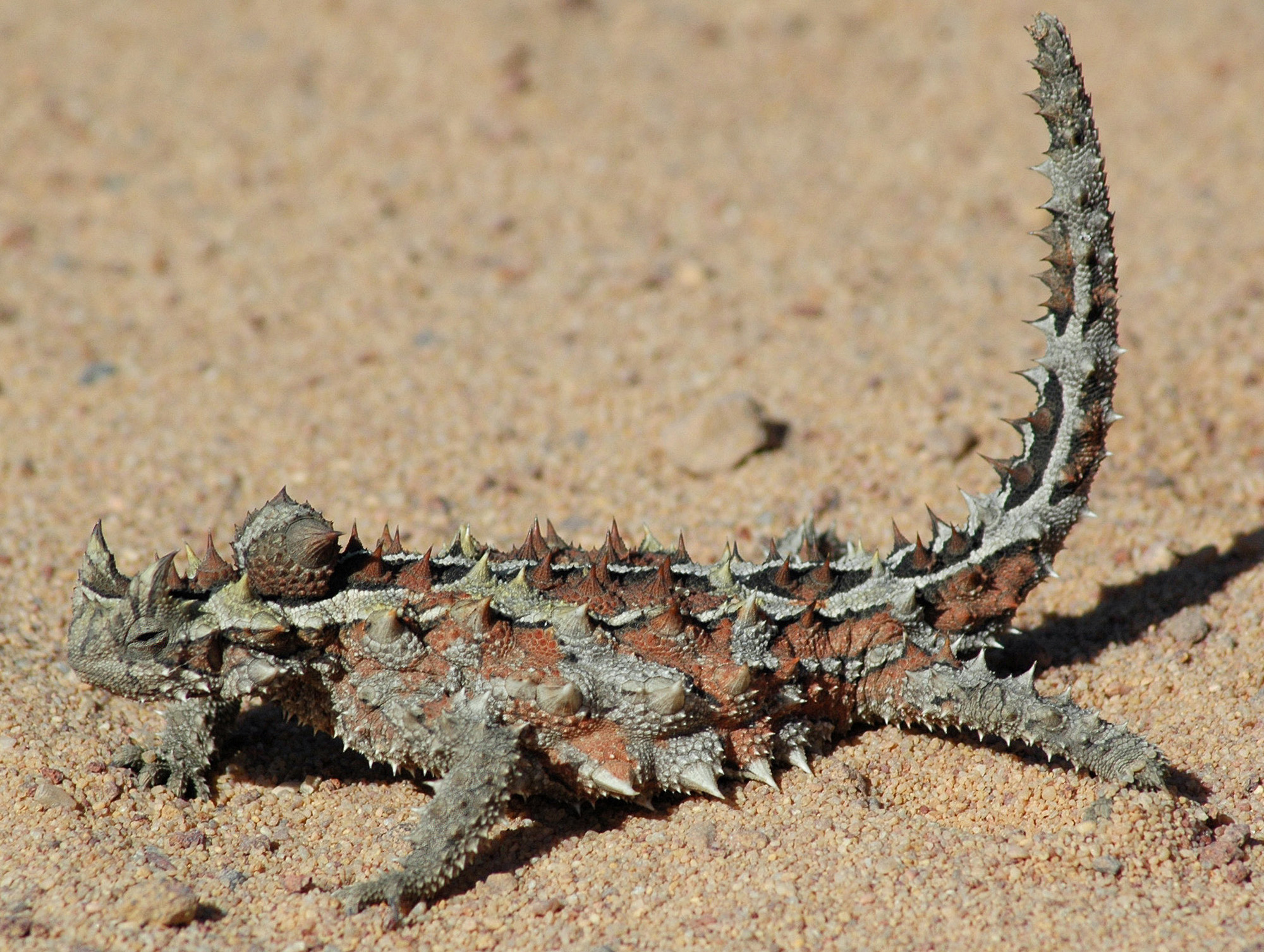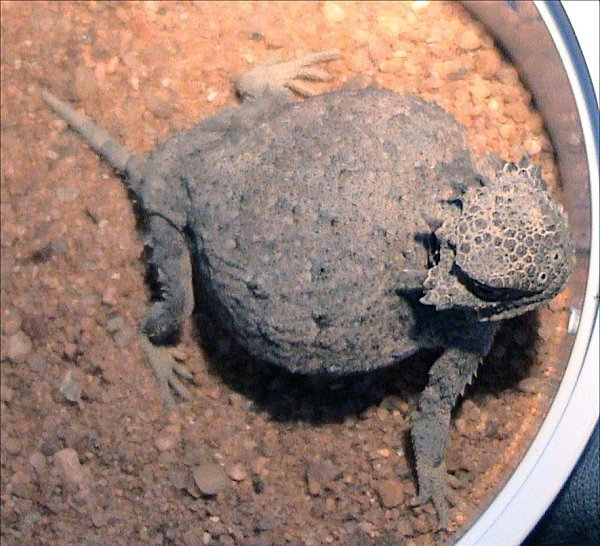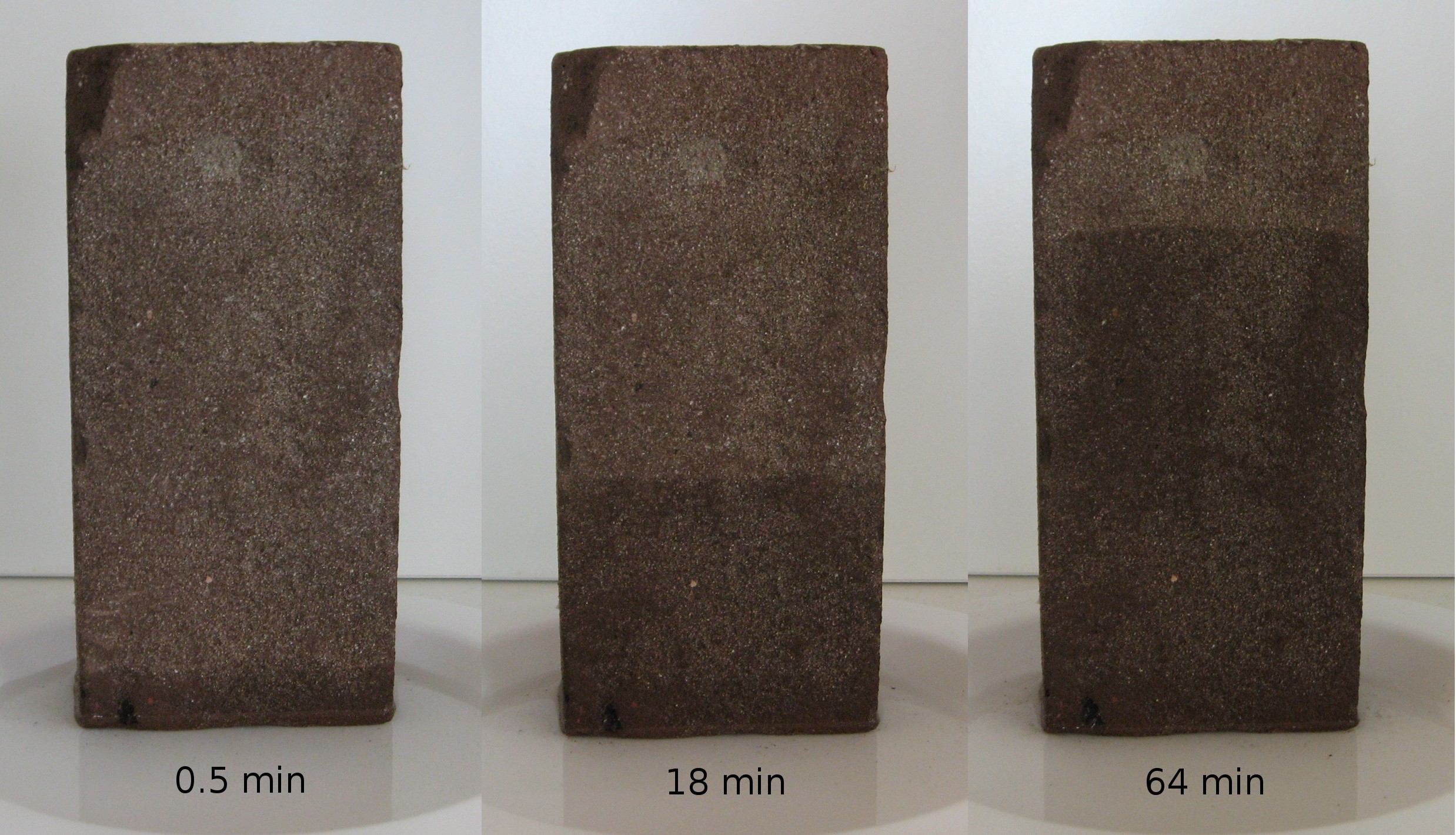|
Moloch Horridus
The thorny devil (''Moloch horridus''), also known commonly as the mountain devil, thorny lizard, thorny dragon, and moloch, is a species of lizard in the family Agamidae. The species is endemic to Australia. It is the sole species in the genus ''Moloch''. It grows up to in total length (including tail), with females generally larger than males. Taxonomy The thorny devil was first described by the biologist John Edward Gray in 1841. While it is the only species contained in the genus ''Moloch'', many taxonomists suspect another species might remain to be found in the wild. The thorny devil is only distantly related to the morphologically similar North American horned lizards of the genus ''Phrynosoma''. This similarity is usually thought of as an example of convergent evolution. The names given to this lizard reflect its appearance: the two large horned scales on its head complete the illusion of a dragon or devil. The name Moloch was used for a deity of the ancient Near ... [...More Info...] [...Related Items...] OR: [Wikipedia] [Google] [Baidu] |
John Edward Gray
John Edward Gray (12 February 1800 – 7 March 1875) was a British zoologist. He was the elder brother of zoologist George Robert Gray and son of the pharmacologist and botanist Samuel Frederick Gray (1766–1828). The same is used for a zoological name. Gray was keeper of zoology at the British Museum in London from 1840 until Christmas 1874, before the natural history holdings were split off to the Natural History Museum. He published several catalogues of the museum collections that included comprehensive discussions of animal groups and descriptions of new species. He improved the zoological collections to make them amongst the best in the world. Biography Gray was born in Walsall, but his family soon moved to London, where Gray studied medicine. He assisted his father in writing ''The Natural Arrangement of British Plants'' (1821). After being blackballed by the Linnean Society of London, Gray shifted his interest from botany to zoology. He began his zoological ... [...More Info...] [...Related Items...] OR: [Wikipedia] [Google] [Baidu] |
George Albert Boulenger
George Albert Boulenger (19 October 1858 – 23 November 1937) was a Belgian-British zoologist who described and gave scientific names to over 2,000 new animal species, chiefly fish, reptiles, and amphibians. Boulenger was also an active botanist during the last 30 years of his life, especially in the study of roses. Life Boulenger was born in Brussels, Belgium, the only son of Gustave Boulenger, a Belgian public notary, and Juliette Piérart, from Valenciennes. He graduated in 1876 from the Free University of Brussels (1834–1969), Free University of Brussels with a degree in natural sciences, and worked for a while at the Royal Belgian Institute of Natural Sciences, Brussels, as an assistant naturalist studying amphibians, reptiles, and fishes. He also made frequent visits during this time to the ''National Museum of Natural History (France), Muséum national d'Histoire naturelle'' in Paris and the Natural History Museum, London, British Museum in London. Boulenger develop ... [...More Info...] [...Related Items...] OR: [Wikipedia] [Google] [Baidu] |
Trapelus Flavimaculatus
The yellow-spotted agama (''Trapelus flavimaculatus'') is a common species of lizard in the family Agamidae. The species is endemic to the Middle East. Geographic range ''T. flavimaculatus'' is found in arid regions of the Arabian Peninsula in Oman, Qatar, Saudi Arabia, United Arab Emirates, and Yemen. Habitat The yellow-spotted agama inhabits sandy or gravelly areas of desert and shrubland, at altitudes from sea level to . Diet ''T. flavimaculatus'' feeds mostly on insects. Behaviour The yellow-spotted agama is diurnal, and climbs on bushes to bask. Reproduction ''T. flavimaculatus'' is oviparous. Clutch A clutch is a mechanical device that allows an output shaft to be disconnected from a rotating input shaft. The clutch's input shaft is typically attached to a motor, while the clutch's output shaft is connected to the mechanism that does th ... size is four to six eggs. Description Males of ''T. flavimaculatus'' are generally known by the remarkable blue colour on ... [...More Info...] [...Related Items...] OR: [Wikipedia] [Google] [Baidu] |
Phrynocephalus Horvathi
''Phrynocephalus horvathi'' is a small diurnal desert lizard in the family Agamidae. It is endemic to the valley of the Aras River and considered Critically Endangered. Taxonomy The phylogeny within the genus ''Phrynocephalus'' is not well understood and has been the subject of recent revisions. Following Melnikov et al. (2008), the IUCN considers ''P. horvathi'' and ''P. persicus'' different species rather than subspecies of ''P. persicus'' (for details see '' Phrynocephalus persicus''). This usage has been followed here, contrary to the Reptile Database. Description The neotype, an adult male, measures in snout–vent length, and has a tail. The body is slender and depressed; also the head is depressed. There is a crest, consisting of a row of nine thornlike scales, along the middle line of neck. Distribution and habitat ''P. horvathi'' occurs in several isolated populations the valley of the Aras River in Armenia, Azerbaijan, and Turkey, at elevations of up to 500 m. Like ' ... [...More Info...] [...Related Items...] OR: [Wikipedia] [Google] [Baidu] |
Phrynocephalus Helioscopus
''Phrynocephalus helioscopus'', the sunwatcher toadhead agama, Fergana toad-headed agama, or sunwatcher, is a species of agamid lizard found in Kazakhstan, S Russia, Turkmenistan, Uzbekistan, Kyrgyzstan, Tajikistan, Turkey, Iraq, China, Mongolia, and Iran Iran, officially the Islamic Republic of Iran (IRI) and also known as Persia, is a country in West Asia. It borders Iraq to the west, Turkey, Azerbaijan, and Armenia to the northwest, the Caspian Sea to the north, Turkmenistan to the nort .... References helioscopus Reptiles described in 1771 Taxa named by Peter Simon Pallas {{Agamidae-stub ... [...More Info...] [...Related Items...] OR: [Wikipedia] [Google] [Baidu] |
Phrynocephalus Arabicus
Arabian toad-headed agama (''Phrynocephalus arabicus'') is a species of agamid lizard found in Saudi Arabia, Qatar, United Arab Emirates, Oman, Iran, and Jordan. Description It is one of 34 recognized species within the genus ''Phrynocephalus''. In 2014, Melkinov split ''P. arabicus'' into 4 distinct species: ''arabicus sensu stricto'', ''nejdensis'', ''macropeltis'', and ''ahvazicus''. To date only '' P. ahvazicus'' has been formally recognized as a separate species. ''P. arabicus sensu stricto'' is recognizable by its unique tail coloration. It has a white coloration on the underside of the tail with a black tip. When the animal is alerted the whole last quarter of the tail becomes black. ''P. arabicus'' also has a relatively long tail and a pointed snout. Adults may attain a snout-to-vent length (SVL) of 51 mm (2 in) and weigh 4.08g on average. Behavior This species is diurnal. They are insectivore file:Common brown robberfly with prey.jpg, A Asilidae, ... [...More Info...] [...Related Items...] OR: [Wikipedia] [Google] [Baidu] |
Phrynosoma Modestum
The roundtail horned lizard (''Phrynosoma modestum'') is one of the smaller species of horned lizard. Their specific epithet is from the Latin word ''modestum'', meaning modest or calm. They are found in the United States, in western Texas, New Mexico eastern Arizona, southeastern Colorado and eight states in northcentral Mexico where they are referred to as "''tapayaxtin''". Habitat Roundtail horned lizards prefer rocky and sandy, semiarid habitat with sparse vegetation, near harvester ant or especially honeypot ant colonies, which is their primary diet. Description The color of roundtail horned lizards usually reflects the color of the soil in their native habitat. Most are uniformly grey in color, but they can also be light brown, or even a pale yellow. Often, darker-colored regions occur around the neck and groin, and sometimes striping on the tail. They are short, flat, round-bodied lizards with short limbs, and small heads, which have a distinctive crest of nearly equ ... [...More Info...] [...Related Items...] OR: [Wikipedia] [Google] [Baidu] |
Texas Horned Lizard
The Texas horned lizard (''Phrynosoma cornutum'') is one of about 21 North American species of spikey-bodied reptiles called horned lizards, all belonging the genus '' Phrynosoma''. It occurs in south-central regions of the US and northeastern Mexico, as well as several isolated introduced records and populations from Southern United States. Though some populations are stable, severe population declines have occurred in many areas of Texas and Oklahoma. The Texas spiny lizard (''Sceloporus olivaceus'') may be confused for a Texas horned lizard due to its appearance and overlapping habitat. Because the Texas horned lizard is listed as a threatened species in the state, it is illegal to pick up, touch, or possess them in Texas. Etymology The horned lizard is popularly called a "horned toad", "horny toad", or "horned frog", but it is neither a toad nor a frog. The popular names come from the lizard's rounded body and blunt snout, which give it a decidedly batrachian appearance. '' ... [...More Info...] [...Related Items...] OR: [Wikipedia] [Google] [Baidu] |
Superhydrophilicity
Superhydrophilicity refers to the phenomenon of excess hydrophilicity, or attraction to water; in superhydrophilic materials, the contact angle of water is equal to zero degrees. This effect was discovered in 1995 by the Research Institute of Toto Ltd. for titanium dioxide irradiated by sunlight. Under light irradiation, water dropped onto titanium dioxide forms no contact angle (almost 0 degrees). Superhydrophilic material has various advantages. For example, it can defog glass, and it can also enable oil spots to be swept away easily with water. Such materials are already commercialized as door mirrors for cars, coatings for buildings, self-cleaning glass, etc. Several mechanisms of this superhydrophilicity have been proposed by researchers. One is the change of the surface structure to a metastable structure, and another is cleaning the surface by the photodecomposition of dirt such as organic compound Some chemical authorities define an organic compound as a chemical com ... [...More Info...] [...Related Items...] OR: [Wikipedia] [Google] [Baidu] |
Keratin
Keratin () is one of a family of structural fibrous proteins also known as ''scleroproteins''. It is the key structural material making up Scale (anatomy), scales, hair, Nail (anatomy), nails, feathers, horn (anatomy), horns, claws, Hoof, hooves, and the outer layer of skin in vertebrates. Keratin also protects epithelial cells from damage or stress. Keratin is extremely insoluble in water and organic solvents. Keratin monomers assemble into bundles to form intermediate filaments, which are tough and form strong mineralization (biology), unmineralized epidermal appendages found in reptiles, birds, amphibians, and mammals. Excessive keratinization participate in fortification of certain tissues such as in horns of cattle and rhinos, and armadillos' osteoderm. The only other biology, biological matter known to approximate the toughness of keratinized tissue is chitin. Keratin comes in two types: the primitive, softer forms found in all vertebrates and the harder, derived forms fou ... [...More Info...] [...Related Items...] OR: [Wikipedia] [Google] [Baidu] |
University Of Western Australia
University of Western Australia (UWA) is a public research university in the Australian state of Western Australia. The university's main campus is in Crawley, Western Australia, Crawley, a suburb in the City of Perth local government area. UWA was established in 1911 by an act of the Parliament of Western Australia. UWA is the oldest university in Western Australia (WA) and the sixth-oldest in Australia. It is classed as one of the "sandstone universities", an informal designation given to the oldest university in each state. UWA is a member of the Group of Eight (Australian universities), Group of Eight, which consists of the eight most research-intensive and best-ranked Australian universities. UWA is also a member of the international Matariki Network of Universities. History The university was established in 1911 following the tabling of proposals by a royal commission in September 1910. The original campus, which received its first students in March 1913, was on ... [...More Info...] [...Related Items...] OR: [Wikipedia] [Google] [Baidu] |
Capillary Action
Capillary action (sometimes called capillarity, capillary motion, capillary rise, capillary effect, or wicking) is the process of a liquid flowing in a narrow space without the assistance of external forces like Gravitation, gravity. The effect can be seen in the drawing up of liquids between the hairs of a paint-brush, in a thin tube such as a Drinking straw, straw, in porous materials such as paper and plaster, in some non-porous materials such as clay and liquefied carbon fiber, or in a biological cell. It occurs because of intermolecular forces between the liquid and surrounding solid surfaces. If the diameter of the tube is sufficiently small, then the combination of surface tension (which is caused by Cohesion (chemistry), cohesion within the liquid) and Adhesion, adhesive forces between the liquid and container wall act to propel the liquid. Etymology Capillary comes from the Latin word capillaris, meaning "of or resembling hair". The meaning stems from the tiny, hairl ... [...More Info...] [...Related Items...] OR: [Wikipedia] [Google] [Baidu] |









